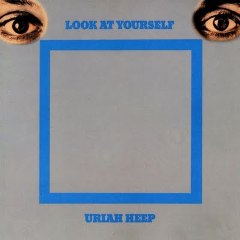Uriah Heep – Look At Yourself (1971)
Uriah Heep – Look At Yourself (1971)

01. Look At Yourself (Hensley) – 5:09
02. I Wanna Be Free (Hensley) – 3:59
03. July Morning (Hensley/Byron) – 10:30
04. Tears In My Eyes (Hensley) – 4:59
05. Shadows Of Grief (Hensley/Byron) – 8:37
06. What Should Be Done (Hensley) – 4:13
07. Love Machine (Hensley/Byron/Box) – 3:37
Personnel:
- David Byron - lead vocals
- Ken Hensley – organ, piano, guitar, acoustic guitar, vocals
- Mick Box – lead guitar, acoustic guitar
- Paul Newton – bass
- Ian Clarke – drums
The third time proved to be the charm for Uriah Heep: on Look at Yourself, the group perfects its fusion of heavy metal power and prog rock majesty, and the result is one of the best albums in the Heep catalog. The gauntlet is thrown down on the title track, a powerful rocker that layers its relentless hard rock attack with ornate vocal harmonies and quicksilver organ runs before climaxing with a tribal-sounding drum jam. The remainder of Look at Yourself presents an effective blend of gutsy guitar rock and organ-fueled prog excursions. In the rock arena, the gems are "Tears in My Eyes," a powerful rocker driven by an almost rockabilly-style riff that stops midway for a surprising vocal harmony break supported by smooth wah-wah guitar, and "Love Machine," a short, punchy slice of hard rock built on an infectious, stomping rhythm. However, the best track on the album is one of the more prog-oriented ones: "July Morning" starts with a pastoral organ riff, then builds into a heavy yet symphonic rock tune that divides its time between gentle acoustic verses and emotional, organ-fueled choruses before climaxing in a monstrous jam dominated by a swirling Moog synthesizer lead. Special note should also be taken of David Byron's vocal performance; his multi-octave, operatic style was no doubt an influence on later metal vocalists like Rob Halford. All in all, Look at Yourself is both one of Uriah Heep's finest, most cohesive albums and a high point of 1970s heavy metal. ---Donald A. Guarisco, AllMusic Review
Od kiedy tylko mogę, to lipiec zaczynam tak samo – budzę się rano, sięgam po taśmę/kasetę/płytę – w różnych latach różnie to bywało - i puszczam sobie „July Morning”. Niezbyt oryginalnie, prawda? Ale sympatycznie. I zawsze robi się z tego mały festiwal Uriah Heep. W lipcu słucham ich w większych ilościach. Tylko, że zwykle tylko tych najwcześniejszych płyt z Byronem, z lat 1970-73, no może jeszcze „Return to Fantasy”.
„Look at Yorself” znam praktycznie od zawsze. To była pierwsza , klasyczna, rockowa płyta, którą poznałem w całości, gdzieś na samym początku lat 80-tych . Nawet analog z lustereczkiem miałem kiedyś w rękach.
Tempo pracy Uriah Heep w tym czasie było zawrotne. W jesieni 1971 wydali już swoją trzecią płytę, a przecież zaledwie kilkanaście miesięcy wcześniej ukazał się ich album debiutancki. A co ważniejsze oba wcześniejsze krążki były naprawdę bardzo dobre. Tak , naprawdę bardzo dobre, chociaż materiał na nich zawarty był dość eklektyczną zbieraniną . Szczególnie debiut był pod tym względem bardzo różnorodny – klasyk zespołu , czyli „Gypsy”, ballada „Come Away Melinda” , creamowskie „Walking in My Shadow” aż po lekko jazzujący „Wake up (Set Your Sight)” , a na drugiej płycie była regularna rockowa suita „Salisbury” (też bardzo dobra) .
„Look at Yourself” to jest pierwszy album jednorodny stylistycznie. Hard-rock – najostrzejsza i najcięższa płyta Jurajów z tego okresu. Przez wielu uważana za najlepszą (ale równie wielu zwolenników ma „Demons And Wizards”). Pomysł, żeby do nagrania utworu tytułowego zaprosić trzech bębniarzy z Osibisa był rewelacyjny. „Look at Yorself” sam w sobie mocny numer, ostro prący do przodu, a jeszcze wzbogacony popisami panów Osei, Tontoh i Amao , tworzących niesamowitą maszynę rytmiczną, jak walec drogowy z silnikiem turboodrzutowym. Inny gość na tej płycie to Mafred Mann. On i jego moog wystąpili w finale dziesięciominutowego „July Morning”, utworu opartego na prostym jak budowa cepa , ale bardzo chwytliwym temacie. Mann nie był osobiście zbyt zachwycony swoją solówka, zespołowi jednak się spodobała.
To dwa najważniejsze momenty na tym albumie. Tytułowy wydany na singlu, był sporym przebojem, Lipcowy Poranek (czyli obowiązkowa dawka epiki na płycie hard-rockowej) to najsłynniejszy utwór zespołu. Pozostałe nie są wcale li tylko wypełniaczami – „Sahdow of Grief”, „Tears in My Eyes”, „Love Machine” (mój kolega ten tytuł tłumaczył – „Jebadełko” :) ) to świetne kompozycje. Cała płyta jest po prostu doskonała. Co tu dużo mówić – klasyka! ---Wojciech Kapała, artrock.pl
download (mp3 @320 kbs):
yandex mediafire ulozto gett bayfiles
Last Updated (Tuesday, 19 March 2019 22:15)








